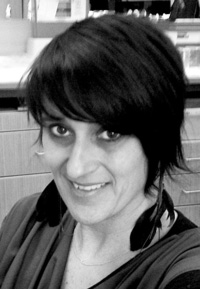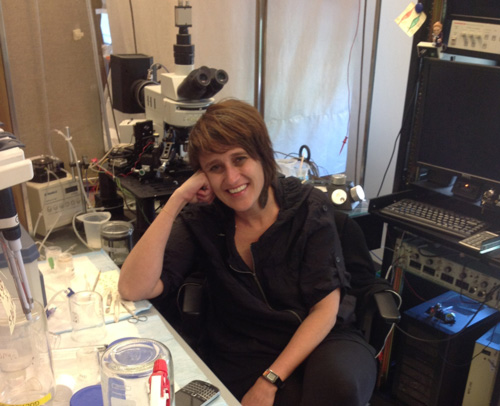Young Scholar Profile: Gul Dolen
 The Bridge: Would you please tell us about yourself and your journey that led you to become a scientist?
The Bridge: Would you please tell us about yourself and your journey that led you to become a scientist?
Gul Dolen: My desire to become a scientist was incited when I was about 8 years old, visiting family in Antalya, Turkey. Having grown up in the USA, and never having seen sea urchins before, I was very afraid of the black, spiny, bizarre creatures littering the sandy beaches, and refused to go into the sea. My grandmother, a high school biology teacher, was able to reassure me of the sea urchins harmlessness, by taking one in her hand, letting me touch its spines, dissecting out its stomach, and showing me its tiny teeth. I spent the rest of the summer swimming in the sea until my fingers were pruned, and the rest of my life fascinated by the wonders of nature.
A few years later, as a student at the Keystone school in San Antonio, TX, I started taking part in regional and international science fair competitions and learned the satisfaction of designing and conducting experiments. As an undergraduate at Duke University, I briefly considered a career in marine biology; however, I was also interested in the philosophy of mind, and ultimately chose to work in a neurobiology lab to research the cellular mechanisms of learning and memory. My honors thesis combined this lab experience with a philosophical consideration of ‘Theory of Mind,’ the absence of which is thought to be the principle brain deficit in Autism.
After university, I wanted to convince myself that there wasn’t a more adventurous career awaiting me, so I managed to get a job as an underwater photographer at the Institute of Nautical Archeology, which was carrying out an excavation of an 1100 year old Byzantine shipwreck off the coast of Bozburun, Turkey. As exciting and glamorous as this work was, by the end of the summer, on our boat rides out to the dive site, I found myself explaining to the archeologists how neurons use chemical signals to communicate with one another, and realized I was hooked on neuroscience. I turned down a job as an artifact photographer in Kenya, and instead started working as a research technician in a neurobiology lab at Columbia University.
During that time, I was impressed by the M.D., Ph.D. students in the lab, and it occurred to me that I might be able to satisfy my desire to combine fieldwork with neuroscience by pursuing the dual degree; after all, I figured, what better “field” to study the brain than a neurology ward (possibly in Kenya). So, while I worked as a technician, I also took courses in physics, organic chemistry, and biochemistry in order to complete my pre-medical requirements.
As an M.D./Ph.D. student at Brown University and MIT, my thesis work focused on finding a cure for Fragile X, the most common identified form of Autism. During this time, I also participated in seeing patients with Autism at the Massachusetts General Hospital genetics clinic and served as a consultant for two pharmaceutical companies, Seaside therapeutics and Pfizer, who were developing pharmaceuticals for the targets I had identified for my thesis work.
T.B.: Tell us about your research and how it is related to everyday life or other fields.
G.D.: After completing my M.D.,Ph.D. I decided that I wanted to pursue a basic research rather than clinical career, so I accepted a postdoctoral fellowship at Stanford University. The research I did as a postdoc, provided the groundwork for understanding the neurobiological basis of social cognition, and has led to the identification of two additional putative treatment targets in Autism.
As an Assistant professor in the Department of Neuroscience at Johns Hopkins University, my lab continues to be interested in understanding the brain circuitry that subserves the pleasure we feel during social interactions, a function that we hypothesize is disrupted in Autism.
T.B.: What are your immediate and long-term goals for the future?
G.D.: Ultimately the goal of this research is to cure Autism, understand the basic mechanisms of social cognition, and ultimately learn something about the biological basis of consciousness.
Despite these ambitious short-term goals, when I listen to my ecologist friend recounting his adventures wading through anaconda-infested swamps in Peru, I am struck with envious longing and am reminded that I once set out to conduct fieldwork in neuroscience. Although it is still not clear to me how I will accomplish this long-term goal, my mind is always searching for ways to create such an opportunity.
T.B.: What do you consider important to your success? Tell us about any skills or habits that you think helped you to become a successful scientist at such a young age.
G.D.: In the early stages of a scientist’s career, a great deal of emphasis is placed on mastering the basic sciences; what is often overlooked, and particularly important in the later stages, is being able to communicate one’s ideas clearly. In fact, I owe as much of my success to my high school English teacher as to my Biology teacher. Furthermore, the university system in the U.S.A. allows its students to develop a breath of skills before having to focus on one field of study. As a result, I was able to take numerous courses in philosophy, which, among other things, honed my ability to formulate abstract arguments, a skill that has been invaluable to my scientific career.
T.B.: What do you recommend to aspiring scientists, or to young Turkish scientists who are at the beginning of their careers?
G.D.: For young scientists, I recommend constant reading, not just in science, but as much outside your field as possible – this habit not only reflexively develops writing skills, it fuels creativity by forcing your worldview into many directions. After all, a scientist’s job is to constantly question not only what we know, but also how we know it, so that we may break free and discover new worlds. Of course, experiments fail more often than they succeed, so it is also absolutely necessary to be both passionate and doggedly tenacious.
T.B.: Thank you very much for sharing your story with us.
